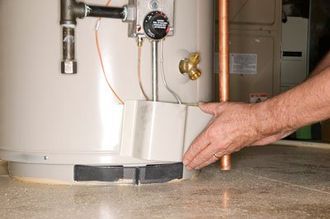This post below on the subject of Eco-Friendly Plumbing Practices for a Greener Home is particularly interesting. You should investigate for yourself.

Intro
In today's world, lasting living is coming to be progressively vital. One area where homeowners can make a substantial effect is through environment-friendly plumbing options. By adopting eco conscious methods, households can minimize their water and power usage while contributing to a healthier world.
Greywater Equipments
Greywater refers to carefully made use of water from resources such as showers, sinks, and washing devices. As opposed to allowing this water go to waste, greywater systems recycle it for non-potable uses such as landscape watering and commode flushing. By implementing a greywater system, property owners can save fresh water resources and reduce pressure on community wastewater therapy centers.
Rainwater Harvesting
Rainwater gathering includes collecting and storing rainwater for different functions, consisting of watering, bathroom flushing, and laundry. Rainwater gathering systems generally consist of a collection surface (such as a roof covering), rain gutters, downspouts, and tank. By gathering rainwater, house owners can minimize their dependence on community water resources and preserve freshwater resources.
Solar Water Heaters
Typical water heaters depend on fossil fuels or electricity to warmth water, contributing to carbon emissions and power usage. On the other hand, solar hot water heater make use of sunlight to warmth water, providing an eco-friendly and environmentally friendly alternative. By taking advantage of solar energy, house owners can decrease their energy expenses and lower their carbon footprint.
Eco-friendly Pipeline Products
Traditional plumbing products such as copper and PVC can have adverse environmental effects during manufacturing and disposal. Nonetheless, there are sustainable choices readily available, such as recycled steel, cross-linked polyethylene (PEX), and high-density polyethylene (HDPE). These environment-friendly pipeline products offer longevity, durability, and lowered environmental effect.
Water-Efficient Components
Standard fixtures commonly drainage needlessly. However, modern-day low-flow commodes, taps, and showerheads are created to minimize water use without giving up performance. These components can considerably minimize household water usage, bring about lower water expenses and a minimized ecological footprint.
Energy-Efficient Home appliances
Along with water-efficient components, energy-efficient devices can better reduce a household's environmental footprint. High-efficiency washing devices and dishwashers use less water and energy per cycle, aiding to preserve sources and lower utility expenses. When purchasing appliances, look for ENERGY STAR ® certified versions for maximum effectiveness.
Smart Water Administration Equipment
Advances in modern technology have made it simpler than ever to keep an eye on and optimize water use in the home. Smart water management systems utilize sensing units and data analytics to track water usage in real-time, recognize leaks, and provide understandings for preservation. By implementing clever water monitoring remedies, property owners can lessen waste and make the most of effectiveness.
Wellness Benefits
In addition to ecological advantages, environment-friendly pipes can additionally add to boosted indoor air quality and health. By using non-toxic products and decreasing chemical exposure, homeowners can develop a much healthier living setting on their own and their households.
Government Incentives
Many federal governments use monetary rewards to motivate house owners to take on green pipes methods. These rewards may consist of discounts, tax obligation credit scores, and low-interest lendings for energy-efficient upgrades. By making use of these programs, home owners can make eco-friendly improvements more budget-friendly and easily accessible.
Expense Factors to consider
While environment-friendly plumbing options may have greater in advance expenses than conventional alternatives, they often give long-lasting cost savings through lowered water and energy bills. In addition, several governments offer rewards such as rebates and tax obligation debts for environmentally friendly upgrades, helping to offset initial expenditures.
Installment and Maintenance
Appropriate installation and regular maintenance are crucial for ensuring the effectiveness and long life of environment-friendly pipes systems. It is very important to hire certified professionals to set up and service these systems to stay clear of concerns and optimize efficiency. Routine maintenance tasks such as looking for leakages and cleansing filters can also help avoid issues and enhance efficiency.
Ecological Advantages
The ecological benefits of environment-friendly pipes are considerable. By saving water and energy, house owners can decrease their carbon footprint and decrease their influence on natural resources. Furthermore, green pipes practices can assist secure ecological communities and preserve biodiversity for future generations.
Conclusion
To conclude, environment-friendly pipes choices use countless advantages for home owners and the setting alike. By buying water-efficient components, greywater systems, rain harvesting, solar hot water heater, eco-friendly pipe products, energy-efficient home appliances, wise water administration systems, and various other sustainable options, houses can reduce their ecological impact, reduced their utility costs, and add to a much healthier world for future generations.
Eco-Friendly Plumbing: Transform Your Home with Sustainable Plumbing Options
Understanding Eco-Friendly Plumbing System
At its core, eco-friendly plumbing is all about minimizing water and energy consumption in your home. It’s a green plumbing revolution changing how we think about our water supply and energy use. It offers many options for homeowners, whether you’re upgrading your home or dealing with an older home. By making these changes, you can help the environment, save money on your water and electricity bills, and create a greener, more sustainable home. So, read on to learn how to use eco-friendly plumbing solutions today.
Low Flow Fixtures: A Key to Water Conservation
One of the cornerstones of eco friendly plumbing is the use of low-flow fixtures. These fixtures, which include faucets, showerheads, and toilets, are designed to use much less water than their traditional counterparts. For instance, low-flow showerheads use significantly less water per minute than a standard showerhead without compromising the quality of your shower.
Low-flow toilets are another excellent example of water-saving options. They use fewer gallons of water per flush, making them a more water-efficient choice. By reducing your water usage, these fixtures contribute to a greener home and substantial savings on your water bills.
Maintaining an Eco-Friendly Plumbing System
Another critical aspect of eco-friendly plumbing is addressing water leaks promptly. A small water leak can waste much water over time, leading to water damage and increased water bills.
Regularly checking your plumbing system and fixing leaks can help save gallons of water and reduce your water bills.
Tankless Water Heaters: Hot Water When You Need It
Tankless water heaters, a popular choice in eco-friendly plumbing, are a revolutionary way to heat water in your home. Unlike traditional water heaters that constantly heat a tank of water, tankless water heaters operate on an on-demand basis. This means they only use energy when you need hot water, making them a more energy-efficient option.
This innovative approach to heating water can significantly reduce the energy your home uses. Traditional water heaters constantly work to keep a water tank heated, which requires much energy. In contrast, tankless water heaters heat water when needed, reducing energy consumption and saving money on energy bills. This is a great way to make your home more eco-friendly and embrace an eco-friendly lifestyle.
Insulating Water Pipes: Maximizing Energy Efficiency
Insulating your water pipes is another effective method in eco-friendly plumbing. Proper insulation can prevent heat loss, ensuring your hot water remains hot as it travels from your water heater to your faucet or showerhead. This means your water heater won’t have to work as hard to heat the water, thus saving energy.
For instance, insulating your water pipes can further enhance energy efficiency if you’re using a tankless water heater, which heats water only when needed. This is because the insulation reduces the heat lost as the hot water travels through the pipes, meaning the heater uses less energy to bring the water to the desired temperature.
Dual Flush Toilets: A Water Saving Option
Dual flush toilets are another excellent eco-friendly plumbing option that can help you save water. These toilets offer two flush options: one for liquid waste and one for solid waste. The liquid waste option uses less water than solid waste, allowing you to choose the water flow for each flush based on your needs.
Using less water for liquid waste, dual flush toilets can save thousands of gallons per year compared to traditional bathrooms. This can lead to significant savings on your water bills and contribute to a more sustainable and eco-friendly home.
Touchless Faucets: Saving Water With a Wave of Hand
Touchless faucets are a modern, eco-friendly plumbing option that can help reduce unnecessary water use. These faucets use motion sensors to turn on and off, meaning they only use water when you need it.
This can be particularly useful in the kitchen, where your hands might be full or dirty. Instead of leaving the water running while you handle food or clean dishes, the faucet will only run when your hand comes near the sensor. This reduces water flow and helps you use less water than traditional faucets, contributing to a more eco-friendly lifestyle.
Eco-Friendly Pipes: Eco-Friendly Plumbing Options
When considering eco-friendly plumbing options, paying attention to the materials used in your plumbing system is essential. Some pipes, like those made from copper or stainless steel, are recyclable and more environmentally friendly than PVC pipes. Choosing eco-friendly materials for your pipes can reduce your home’s environmental impact and create a more sustainable plumbing system. By making these small changes, you can make a big difference in your home’s eco-friendliness.
Eco-Friendly Plumbing: Make Your Home Greener
Switching to eco-friendly plumbing options can have a significant positive impact on the environment and your wallet. Not only can these changes reduce your water and energy consumption, but they can also help prevent water waste and damage, contributing to a healthier planet.
Eco-friendly plumbing is more than just a trend; it’s a lifestyle change contributing to a more sustainable future. By making these changes in your home, you can help the planet while saving money on your water and energy bills.
https://intownplumbingtx.com/articles/eco-friendly-plumbing/

I discovered that content on when doing a lookup on the internet. Do you know about somebody else who is inquisitive about the subject? Feel free to share it. Thanks a bunch for being here. Come back soon.
Book Maintenance